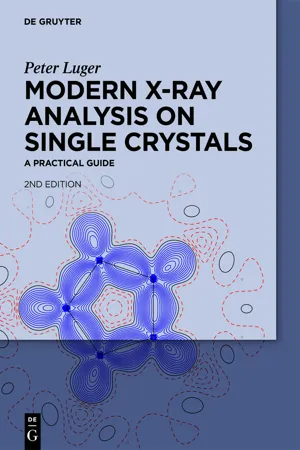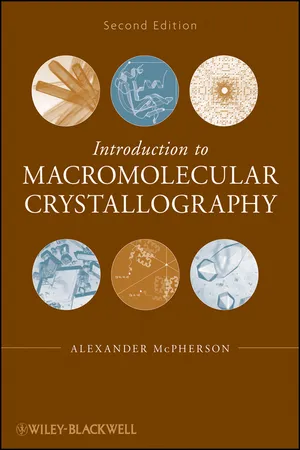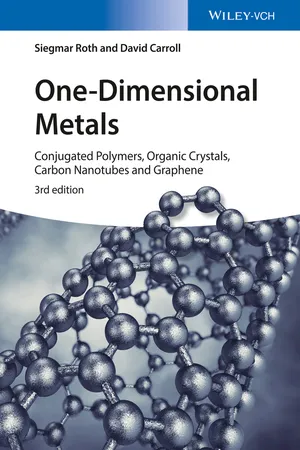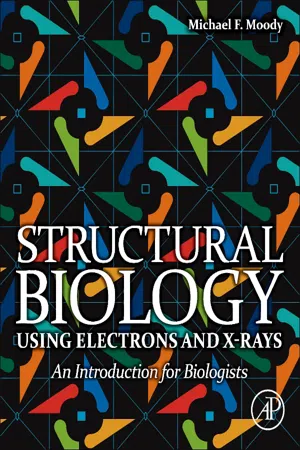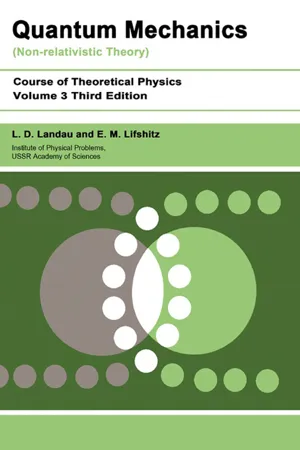Physics
Symmetry in Crystals
Symmetry in crystals refers to the arrangement of atoms or molecules within a crystal lattice. It is characterized by the repetition of a pattern in different directions, reflecting the symmetry of the crystal structure. This symmetry is described using mathematical principles and is important in understanding the physical properties and behavior of crystals.
Written by Perlego with AI-assistance
Related key terms
Related key terms
1 of 4
Related key terms
1 of 3
9 Key excerpts on "Symmetry in Crystals"
- eBook - ePub
- Peter Luger(Author)
- 2014(Publication Date)
- De Gruyter(Publisher)
4 Crystal symmetry4.1 Symmetry operations in a crystal lattice
4.1.1 Introduction
It was already mentioned in the Introduction, Section 1.1 , that crystals have outstanding macroscopic properties. From optical inspection more or less pronounced symmetry of the crystal faces can be recognized, causing a beauty which makes crystals so attractive that some of them are admired as precious stones. In this respect crystals belong to the most expensive solid materials. One carat (0.2 g) of a good quality single crystal of diamond costs about 15 to 20 thousand Euros, which is much more than, for example, one carat of gold or platinum, which is three orders of magnitude cheaper. The symmetry which is macroscopically visible must exist also microscopically in the crystal lattice. First indications were already seen on the various film exposures we described in Chapter 3 , where the diffraction pattern showed a symmetry which must have its correspondence in the crystal symmetry. So we have to consider which symmetry can occur in a crystal. Then we have to examine the consequences of crystal symmetry for the intensity of the diffraction pattern. It is important to care for that question, because investigators are interested in the minimum number of necessary measurements. We have learned already that the number of reflections which can be recorded is a fixed number given by equation (2.11) . It is therefore quite useful to know how the symmetry properties of the crystal can reduce the amount of experimental data required and also the number of atomic parameters to be determined.Figure 4.1 illustrates two different arrangements in a crystal. In Figure 4.1(a) we have a pattern where the only symmetry is periodicity. The unit cell is the smallest nonperiodic volume element consisting of one motif. In Figure 4.1 (b), however, the situation is quite different. Here the motif is present in four different orientations. The identical motif reappears first after having passed another one in both directions. The lattice constants have twice the magnitude of those of Figure 4.1 - eBook - ePub
- Walter A. Harrison(Author)
- 2012(Publication Date)
- Dover Publications(Publisher)
3 will lie below the plane and provide the negative projections completing the six-pointed star. A rotation by 60°, however, will not take the translation vectors into each other; a 120° rotation is required for that. This type of threefold symmetry arises for [111] axes in cubic crystals. The argument given, however, does rule out fivefold symmetry.Limitations such as this reduce the possible point groups for crystals to 32 distinct groups, and all crystal structures can be classified as one of these symmetries. We can make a further classification of crystal types by noting the fuller set of operations making up the space group, and there are 230 space groups. The classification of solids in this way is part of the subject of crystallography.A knowledge of the symmetry of the crystal tells a great deal about the possible behavior which may be found in that crystal. We may obtain such information in a systematic way by using the mathematics of groups, and we will wish to develop the rudiments of group theory for that purpose. Group theory, however, is a large subject in its own right and it will be more appropriate here to begin exploring the consequences of symmetry and to see how the concepts of group theory arise in this context. We will begin by seeing what can be learned about the physical tensors associated with crystals.3. Physical Tensors
We will give here a very brief account of a study which has been described in detail by Nye.1Many macroscopic properties of crystals can be described in terms of tensors. One such property is the conductivity, relating the electric-field vector and the current-density vector. For an isotropic material (such as a metal made of many crystalites) the conductivity is given by a scalar, or equivalently by a scalar times the unit tensor. In more complicated systems, the current will still be proportional to the field (at low fields) but may not be parallel, and the proportionality constants may depend upon the direction of the field. In such a case we may fix a coordinate system in the laboratory and orient the crystal with respect to that system. Then the components of the current are related to the components of the electric field by - eBook - ePub
- Richard J. D. Tilley(Author)
- 2020(Publication Date)
- Wiley(Publisher)
Chapter 5 Symmetry and Physical PropertiesWhat are polar and axial vectors?What are enantiomorphic pairs?What are magnetic point groups?In this chapter the relationship between the existence or absence of a physical property in a crystal and the symmetry of the crystal is outlined. These relationships are specified in terms of the point groups described in the preceding chapter and are generally treated in terms of tensor mathematics. Here, a few less complex examples are given, to illustrate the connection between properties and crystal structure, using optical, dielectric and magnetic properties as examples.5.1 Properties and Symmetry
The chemical and physical properties of a crystal are determined by a number of interlinked factors. Whilst the magnitude of the property usually reflects the atomic constituents present, the presence (or absence) of a physical property is frequently (but not always) dependent upon the underlying crystal symmetry. For a number of properties, the symmetry of the material is irrelevant. Density is simply dependent upon the number and type of atoms present in a unit cell, not their arrangement in space. Temperature, which is a measure of the vibration and rotation of the atoms that make up a material, is similar. Properties that do not reveal symmetry are called non‐directional. Their magnitude is given by a scalar (number) together with the appropriate units.On the other hand, directional properties, which need to be specified by a vector, can reveal aspects of the symmetry of the phase. For example, the symmetry of a crystal is partially revealed by the shape of the pits that form on surfaces when a crystal begins to dissolve in a solvent. Initial attack is at a point of enhanced chemical reactivity, often where a dislocation reaches the surface; the disruption to the atomic packing and the resultant strain field enhances the local solubility. A pit forms as the crystal is corroded. The shapes of the pits, called etch figures - eBook - ePub
- Kevin Hefferan, John O'Brien(Authors)
- 2022(Publication Date)
- Wiley-Blackwell(Publisher)
Chapter 4 Crystallography- 4.1 Crystalline substances
- 4.2 Symmetry operations
- 4.3 Two‐dimensional motifs and lattices (meshes)
- 4.4 Three‐dimensional motifs and lattices
- 4.5 Crystal systems
- 4.6 Indexing planes in crystals
- 4.7 Twinned crystals
- 4.8 Crystal defects
- 4.9 Polymorphs and pseudomorphs
4.1 CRYSTALLINE SUBSTANCES
Crystallography emphasizes the long‐range order or crystal structure of crystalline substances. It focuses on the symmetry of crystalline materials and on the ways in which their long‐range order is related to the three‐dimensional repetition of fundamental units of pattern during crystal growth. In minerals, the fundamental units of pattern are molecular clusters of coordination polyhedra or stacking sequences (Chapter 2 ). The ways in which these basic units can be repeated to produce crystal structures with long‐range order are called symmetry operations. Crystallography is also focused on the description and significance of planar features in crystals including planes of atoms, cleavage planes, crystal faces, and the forms of crystals. In addition, it is concerned with crystal defects which are local imperfections in the long‐range order of crystals.4.1.1 Crystals and crystal faces
Mineral crystals are one of nature's most beautiful creations. Many crystals are enclosed by flat surfaces called crystal faces. Crystal faces are formed when mineral crystals grow, and enclose crystalline solids when they stop growing. Perfectly formed crystals are notable for their remarkable symmetry (Figure 4.1 - eBook - ePub
General Physics
Mechanics and Molecular Physics
- L D Landau(Author)
- 2013(Publication Date)
- Pergamon(Publisher)
CHAPTER VITHE THEORY OF SYMMETRY
Publisher Summary
Symmetry is one of the most important characteristics of a given physical object and it has a decisive effect on the behavior of the object in many cases. This chapter discusses the possible symmetries of individual molecules. The symmetry properties consist of various symmetry elements. The chapter highlights these elements and discusses stereoisomers. There is a curious effect that depends on the presence or absence of a certain degree of symmetry in the molecule. If a sufficiently asymmetric molecule undergoes a mirror reflection, the resulting molecule is similar to the first but not identical with it. Stereoisomers are completely identical in almost all physical properties. The difference between them appears, in particular, in certain phenomena that occur when light passes through solutions of these substances; for this reason, stereoisomers are also called optical isomers. The difference between stereoisomers has an important effect when they react with other molecules that are also asymmetric. The chapter further discusses crystal lattices, crystal systems, crystal classes, and crystal planes. It also discusses the lattices of the chemical elements and compounds.§40. Symmetry of molecules
The concept of symmetry plays a fundamental part in physics. Symmetry is one of the most important characteristics of a given physical object, and in many cases it has a decisive effect on the behaviour of the object.We shall begin by considering the possible symmetries of individual molecules. The symmetry properties consist of various symmetry elements , which we shall first of all define.A molecule is said to have an axis of symmetry of order n if it is left unchanged in position by a rotation through an angle 2π/n about that axis, where n is any integer: n = 2, 3, 4, …; such an axis is usually denoted by the symbolCn. For example, if a molecule has an axis of symmetry of order 2, this means that the molecule is unchanged in position by a rotation through 180°; that is, each atom A , B , … in the molecule corresponds to another atom A ′, B ′, … of the same kind, located as shown in Fig. 44 relative to A , B , … and the axis. If the molecule has an axis of symmetry of order 3, it is left unchanged in position by rotations through 120° and 240°; for each atom A , the molecule also contains two atoms of the same kind, A ′ and A ″, situated as shown in Fig. 45 - eBook - ePub
- Alexander McPherson(Author)
- 2011(Publication Date)
- Wiley-Blackwell(Publisher)
d ) where the unit cell and its contents are repeated in a periodic manner along the unit cell axes. These translations are called the lattice translations, or lattice vectors, and the corners of the unit cells, define a point lattice.There are a limited number of symmetry elements, some of which are illustrated in Figures 3.4 , 3.5 , and 3.6 , that are permitted in a crystal. We will see why only these in a moment. These include twofold, threefold, fourfold, and sixfold rotation and screw axes, mirror planes, glide planes, and centers of symmetry. All allowed types of crystallographic symmetry elements, and their descriptions are given in the International Tables for X-ray Crystallography , Vol. I. Combination of these elements in all possible ways yields a total of 230 unique three-dimensional space groups of symmetry operations. The space group of a crystal therefore is a description of the means by which the fundamental set of asymmetric units is self-related. The space group of the arrangement shown in Figure 3.2 is specified as 2 2 2, since the asymmetric units of the set are related to one another by three, intersecting, and mutually perpendicular twofold axes.A significant simplification arises when one is dealing with biological molecules (and there are not many, so treasure this one). Many natural products occur only in one stereoisomer. For example, proteins are composed only of L -amino acids, nucleic acids and nucleotides are composed of D -ribose or D -deoxyribose, and most polysaccharides have only one chiral form of monomer. These molecules therefore can crystallize only in space groups that do not posses inversion symmetry (i.e., symmetry that does not require a change in the hand of the molecule). Thus all space groups that contain a center of symmetry, a mirror plane, or a glide plane, which for completeness are illustrated in Figure 3.7 , are eliminated from consideration. For biological macromolecules only 65 distinct space groups are available rather than 230, and these allowable space groups are listed in Table 3.1 - eBook - ePub
One-Dimensional Metals
Conjugated Polymers, Organic Crystals, Carbon Nanotubes and Graphene
- Siegmar Roth, David Carroll(Authors)
- 2015(Publication Date)
- Wiley-VCH(Publisher)
translational invariance of the crystal lattice and of the laws governing the physics within a crystal.Once the most simple, primitive lattice structure has been determined, it is important to realize how many possibilities exist for distinctively different lattices. Different lattices in this context are described by the different symmetry operations that will take the lattice into itself. This is governed by the ratio of lengths in lattice parameters as well as the angles in the lattice. Therefore, the three-dimensional analog of our rectangular lattice mentioned above, with , is a cubic lattice. This lattice has a number of symmetry operations – rotations, translations, reflections, that when performed on this lattice leaves the lattice unaltered. However, in lattices of lower symmetry, the lengths of the elementary cell might differ, ; also the angles between the axes do not need to be 90°. This means that an entirely different set of symmetry operations leaves the lattice unaltered.When the whole set of invariant symmetry operations: rotations and translations on a set of primitive lattice points are considered, they form a mathematical point group. An enumeration of all the possible lattice point groups can be made – which means there are only a finite number of primitive lattice arrangements expressing unique symmetries, that can exist – regardless of the values of the lattice parameters and angles. (Bravais lattices are said to be “equivalent” if they have isomorphic space symmetry groups.) These distinct groups are listed in Ashcroft and Mermin [1] as well as several other solid-state physics texts. In fact, in three-dimensional space, there are 14 possible symmetry groups, or symmetry variations of this most simple lattice. But in two dimensions, there are only 5 such symmetry groups allowed. In zero and one dimension, there is only one type of Bravais or primitive lattice. - eBook - ePub
Structural Biology Using Electrons and X-rays
An Introduction for Biologists
- Michael F Moody(Author)
- 2011(Publication Date)
- Academic Press(Publisher)
Clearly it is connected with the dimensionality of the symmetrical object, since (e.g.) a two-dimensional (2D) object cannot have more than two independent translations. Each symmetry operation (like a rotation or translation) applies to the entire structure (within its boundaries), but small sub-regions may have a different, perhaps higher, symmetry than the whole. This is called local symmetry, and often occurs when crystals are formed of highly symmetrical units, e.g. virus particles. Rotations and translations are the most important and common examples of symmetry operation, and are also the only ones that can exist in an aggregate containing identical subunits that are completely unsymmetrical (like entirely left shoes). The important difference between left- and right-handed structures is called chirality (or handedness or enantiomorphism) and the alternatives are labeled D- and L- (among other notations). Chirality is the aspect of an object's geometry that is altered in a mirror-image, so two molecules of opposite chirality cannot be superposed, even though they have identical distances between corresponding atoms. Biological macromolecules contain monomers, like nucleotides or amino-acid residues, which are chiral. In ordinary nucleic acids or proteins, the chirality is the same, being based, respectively, on D-ribose or L-amino-acids. A symmetry element (e.g. a mirror) that reverses chirality would require the existence of equal numbers of D- and L-ribose molecules, so it cannot apply to ordinary nucleic acids. This restriction does not apply to minerals, and indeed the existence of widespread chirality of the same type is a possible sign of life. Nevertheless, chirality-reversing symmetry elements have limited roles in biology. First, electron microscope images often lack sufficient resolution to show any chirality in the specimen, and the apparent symmetries of such images can contain chirality-reversing operations - eBook - ePub
Quantum Mechanics
Non-Relativistic Theory
- L D Landau, E.M. Lifshitz(Authors)
- 1981(Publication Date)
- Butterworth-Heinemann(Publisher)
CHAPTER XIITHE THEORY OF SYMMETRY
§91 Symmetry transformations
The classification of terms in the polyatomic molecule is fundamentally related to its symmetry, as in the diatomic molecule. Hence we shall begin by examining the types of symmetry which a molecule can have.The symmetry of a body is determined by the assembly of all those rearrangements after which the body is unaltered; these rearrangements are called symmetry transformations . Any possible symmetry transformation can be represented as a combination of one or more of the three fundamental types of transformation. These three essentially different types are: the rotation of the body through a definite angle about some axis, the reflection of it in some plane, and the parallel displacement of the body over some distance. Of these, the last evidently is applicable only to an infinite medium (a crystal lattice). A body of finite dimensions (in particular, a molecule) can be symmetrical only with respect to rotations and reflections.If the body is unaltered on rotation through an angle 2Π/n about some axis, then that axis is said to be an axis of symmetry of the nth order . The number n can take any integral value: n = 2, 3, …. The value n = 1 corresponds to a rotation through an angle of 2Π or, what is the same thing, of 0, i.e. it corresponds to an identical transformation. We shall symbolically denote by C n the operation of rotation through an angle 2Π/n about a given axis. Repeating this operation two, three, … times, we obtain rotations through angles 2(2Π/n ), 3(2Π/n ), …, which also leave the body unaltered; these rotations may be denoted by . It is obvious that, if p divides n ,(91.1)In particular, performing the rotation n times, we return to the initial position, i.e. we effect an identical transformation. The latter is customarily denoted by E , so that we can write(91.2)If the body is left unaltered by a reflection in some plane, this plane is said to be a plane of symmetry
Index pages curate the most relevant extracts from our library of academic textbooks. They’ve been created using an in-house natural language model (NLM), each adding context and meaning to key research topics.
Explore more topic indexes
Explore more topic indexes
1 of 6
Explore more topic indexes
1 of 4
